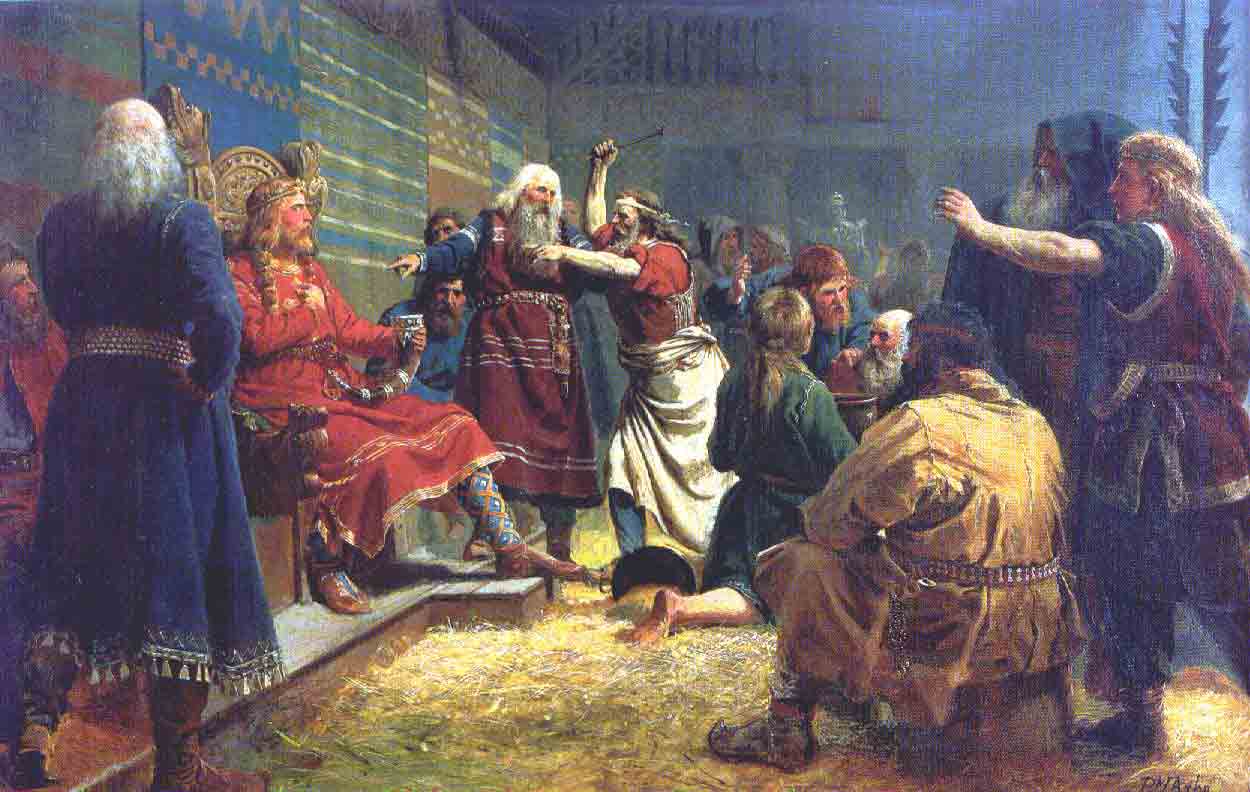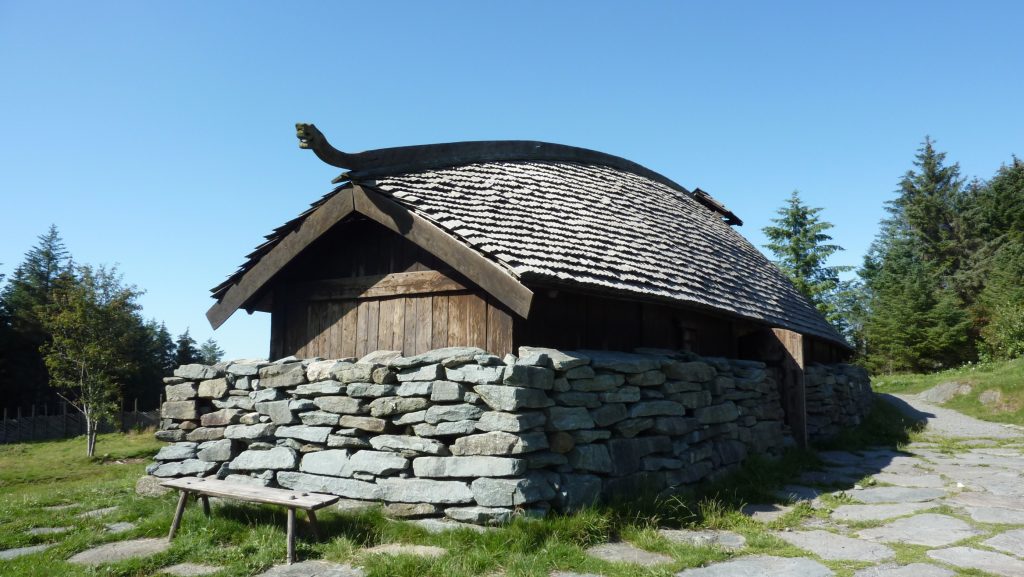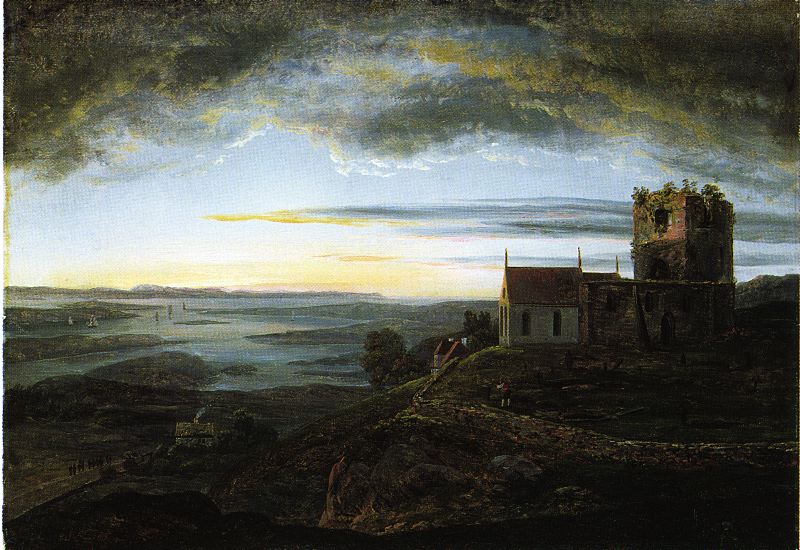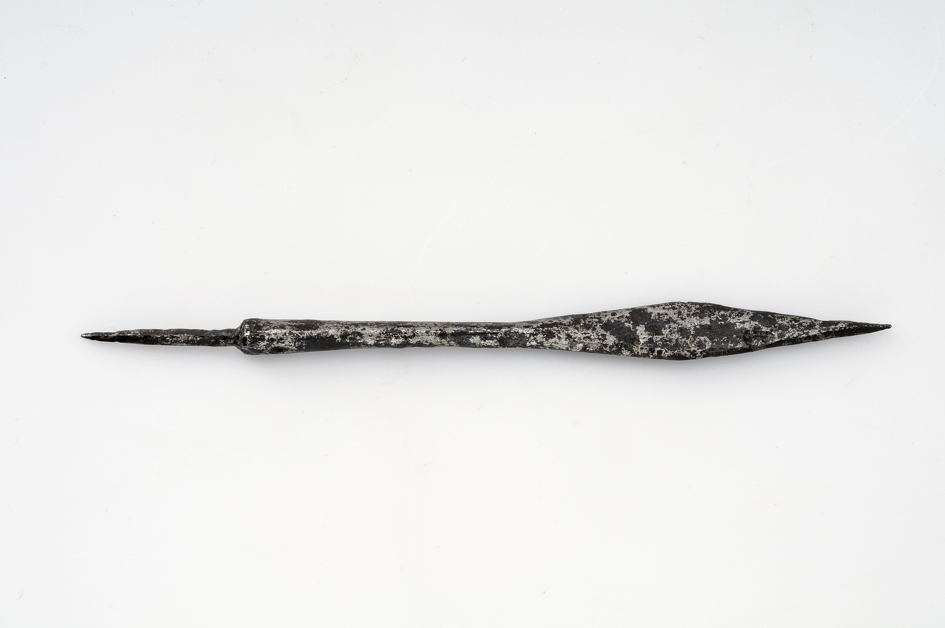
Haakon the Good (c. 920-961) by Peter Nicolai Arbo
Around the year 934, shortly after the death of Norway’s legendary King Harald Fairhair, his youngest son Haakon – raised in Northumbria by King Athelstan (Æthelstan) – returned to usurp the throne bequeathed to Harald’s beloved but unpopular son Eric Bloodaxe. Eric lost the support of key allies, and was forced into exile in Northumbria, where he reigned over that land until his battlefield demise sometime around 944. Thus, when Eric died, his five formidable sons (Eiriksønnene) were forced into the sea, and subdued the islands of Orkney and Shetland, but harbored sentiments of revenge and conquest directed at the throne and kingdom of their uncle in their father’s homeland. Haakon, however, underestimated their resolve.

According to the Heimskringla – a history of the Norwegian kings written in the early thirteenth century by Icelandic historian Snorri Sturluson – “When King Hakon heard of his brother Eirik’s death, and also that his sons had no footing in England, he thought there was not much to fear from them, and he went with his troops one summer eastward to Viken” – where he battled the Vikings that ruled those lands from Denmark. After his victories, he extended his campaign into Jutland, Zealand, and later Vinland – known in those days as the lands along the northern Baltic coast, including Pomerania:
Thereafter King Hakon carried war far and wide in Seeland; plundering some, slaying others, taking some prisoners of war, taking ransom from others, – and all without opposition. Then Hakon proceeded along the coast of Scania, pillaging everywhere, levying taxes and ransoms from the country, and killing all vikings, both Danish and Vindish.[1]
When the family of Eric Bloodaxe heard of Haakon’s warring with Denmark “they began to turn their course from the West” and married one of Eric’s daughters into the Danish dynasty ruled by Harald Bluetooth, who was also their uncle. Both clans had common cause. Soon after, Eric’s wife “Gunhild and her sons came from the westward to Denmark, they were well received by King Harald. He gave them great fiefs in his kingdom, so that they could maintain themselves and their men very well.”
Since Eric’s sons could rightly claim the Norwegian throne, this alliance became the basis of their mutual desire for revenge and aggrandizement – which in the end favored Denmark’s control over the northern kingdom. “Some of Eirik’s sons went out on viking expeditions as soon as they were old enough, and gathered property, ravaging all around in the East sea. They grew up quickly to be handsome men, and far beyond their years in strength and perfection.” Among these, were Gamle (the eldest), Guttorm, Sigurd Sleva, Erling Eiriksson, and Harald Greycloak.[2]
Battle of Augvaldsnes (Avaldsnes)
In 953 the sons of Eric Bloodaxe traveled “from Denmark to Viken, and had driven King Trygve Olafson from his ships at Sotanes, and then had plundered far and wide around in Viken, and that many had submitted to them.”

Soon after, Haakon heard of this and sailed south to meet them in battle on land at a place called Avaldsnes, near present-day Haugesund. It was there that Guttorm was slain, and Haakon victorious:
The king’s voice waked the silent host
Who slept beside the wild sea-coast,
And bade the song of spear and sword
Over the battle plain be heard.
Where heroes’ shields the loudest rang,
Where loudest was the sword-blade’s clang,
By the sea-shore at Karmt Sound,
Hakon felled Guthorm to the ground.[3]
Battle of Rastarkalv
In 955 Eiriksønnene again sailed north to meet Haakon in battle, but that time they met deeper in the heart of Haakon’s kingdom, on the island of Frei, in Romsdal county – near present-day Kristiansund. King Haakon had nine ships and Eiriksønnen had twenty, but the king had Egil Ullserk, an old warrior who fought with Haakon’s father and told his king before battle that “‘peace had lasted so long I was afraid I might come to die the death of old age, within doors upon a bed of straw, although I would rather fall in battle following my chief. And now it may so turn out in the end as I wished it to be.’” Leading the sons of Eric was King Gamle, the eldest of the brothers bent on revenge. According to the Heimskringla, Egil “asked King Hakon to give him ten men with ten banners,” and directed them to wave them in such a way “high over the edge of the ridge” that the Danes who accompanied Eiriksønnene believed they were outnumbered, and fled to their ships before the battle quickened. Soon after, Egil…
…and King Gamle exchanged blows with each other, and King Gamle got a grievous wound; but Egil fell, and many people with him. Then came Hakon the king with the troops which had followed him, and a new battle began… When Eirik’s sons saw their men falling all round, they turned and fled to their ships; but those who had sought the ships before had pushed off some of them from the land, while some of them were still hauled up and on the strand. Now the sons of Eirik and their men plunged into the sea, and betook themselves to swimming. Gamle Eirikson was drowned; but the other sons of Eirik reached their ships, and set sail with what men remained. They steered southwards to Denmark, where they stopped a while, very ill satisfied with their expedition.[4]
Battle of Fitjar
Six years later, in the twenty-sixth year of his reign (961), Haakon took part in a feast at Hordaland at a place named Fitjar on the island of Stord. It was there while feasting that his watchmen “outside observed many ships coming sailing along from the south, and not very far from the island.”
Eyvindr Finnsson, Haakon’s court poet, notified the king of the approaching force, which was much larger than that of the king’s, and suggested they flee to fight another day. “The king replied, ‘Thy counsel, Eyvind, is manly, and after my own heart; but I will hear the opinion of others upon this matter.’” The king’s warriors answered, “that they would rather fall bravely and like men, than fly before the Danes; adding, that they had often gained the victory against greater odds of numbers.” And thus it was decided to end the feast and meet the last three sons in battle – Erling Eiriksson, Sigurd Sleva and Harald Greycloak (Greyhide). “When both lines met there was a hard combat, and much bloodshed. The combatants threw their spears, and then drew their swords.” Eyvindr Finnsson chronicled the clash:
The body-coats of linked steel,
Like water fly before the swing
Of Hakon’s sword – the champion-king.
The woven iron coats of mail,
About each Gotland war-man’s head
Helm splits, like ice beneath the tread,
Cloven by the axe or sharp sword-blade.
The brave king, foremost in the fight,
Dyes crimson-red the spotless white
Of his bright shield with foemen’s gore, –
Amidst the battle wild uproar,
Wild pealing round from shore to shore.[5]
Haakon’s Death
In the midst of battle, King Haakon was pierced in the arm with an arrow “but the blood ran from it so much and so constantly, that it could not be stopped; and when the day was drawing to an end his strength began to leave him.”

Haakon and his warriors had once again been victorious against a tenacious foe, but he was heirless, thus on his deathbed proclaimed that Eric’s sons “should be kings over the country; but asked them to hold his friends in respect and honour.” Although Haakon was apparently a Christian, Eyvindr Finnsson, wrote a poem called the Hákonarmál, about the king’s death in battle and entry into Valhalla:
In Odin’s hall an empty place
Stands for a king of Yngve’s race;
‘Go, my valkyries,’ Odin said,
‘Go forth, my angels of the dead,
Gondul and Skogul, to the plain
Drenched with the battle’s bloody rain,
And to the dying Hakon tell,
Here in Valhal shall he dwell.’
Thus the Battle of Fitjar marked the end of Haakon’s reign. Harald Greycloak, the eldest of the remaining three nephews, became King Harald II of Norway, and his brothers took lesser realms. The saga says: “Gunhild’s sons resided mostly in the middle of the country, for they did not think it safe for them to dwell among the people of Throndhjem or of Viken, where King Hakon’s best friends lived; and also in both places there were many powerful men.” Harald Greycloak ruled nearly ten years before he was killed in Denmark by man named Haakon, who sought his own revenge for the acts committed by Greycloak on his father.[6]
[1] Samuel Laing, The Heimskringla or the Sagas of the Norse Kings From the Icelandic of Snorre Sturlason, vol. 2 (New York: Scribner & Welford, 1889), 3-12.
[2] Ibid. 13-14.
[3] Ibid. 27-8.
[4] Ibid. 31-5.
[5] Ibid. 37-40. For speculation regarding martial rituals surrounding these battles, see: Andreas Nordberg, “What Did King Hákon góði Do before the Battle at Fitjar and after the Battle at Avaldsnes?” Religionsvidenskabeligt Tidsskrift, no. 74 (2022): 119–138.
[6] Ibid. 43-49. See: Sverre Bagge, “A Hero between Paganism and Christianity. Håkon the Good in memory and history.” Peter Lang, 2004: 185-210
About the author
Benjamin J. Swenson is an assistant professor at Hoseo University in Asan, South Korea. He holds a PhD from Pompeu Fabra University in Barcelona, Spain, where his dissertation addressed Euro-American military history and the advent of guerrilla warfare and counterinsurgency doctrine in the nineteenth century. His work has recently appeared in the Journal of Military History, and his latest, The Dawn of Guerrilla Warfare, will be published by UK’s Pen & Sword in 2023. His hobbies include Viking sagas and chess.